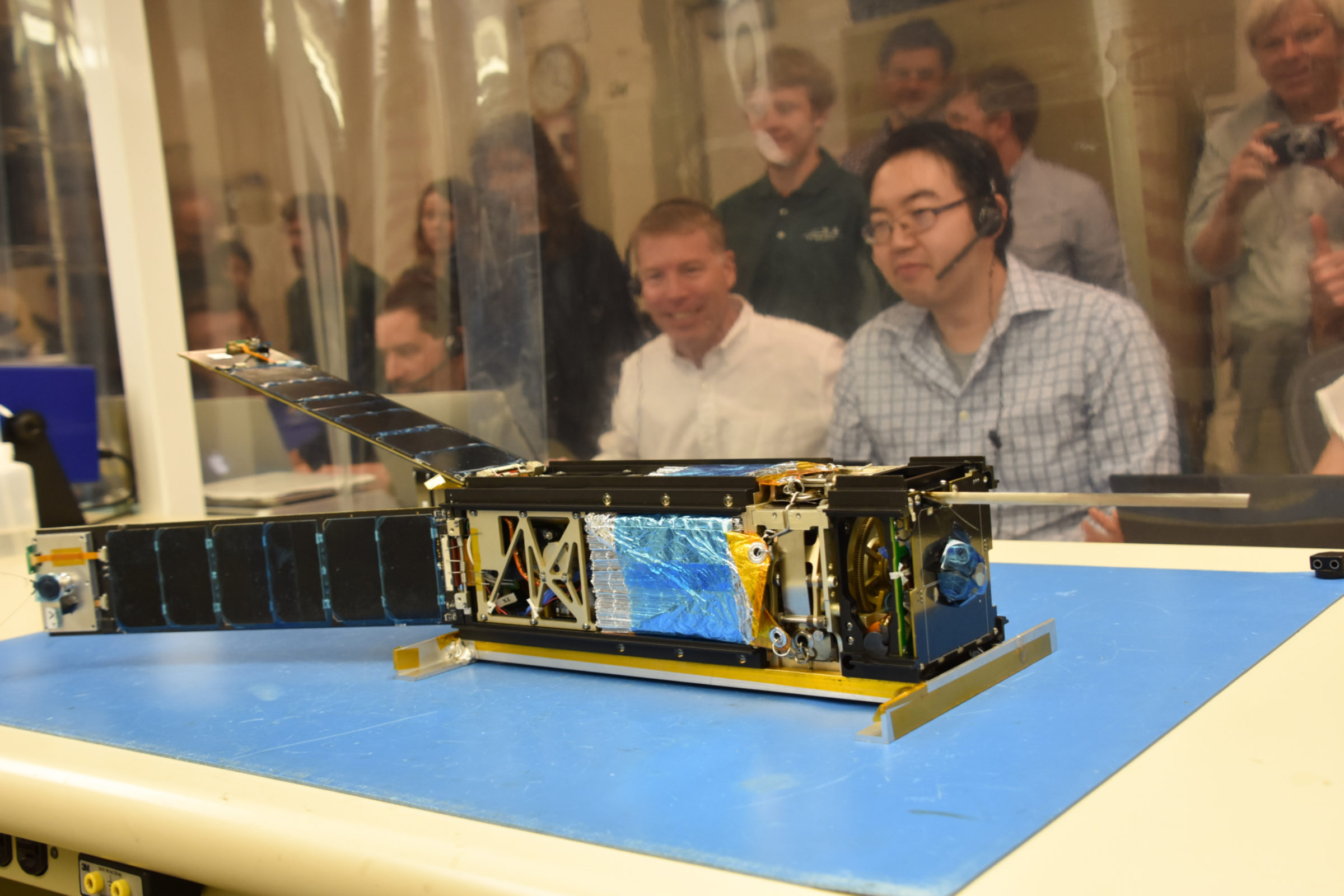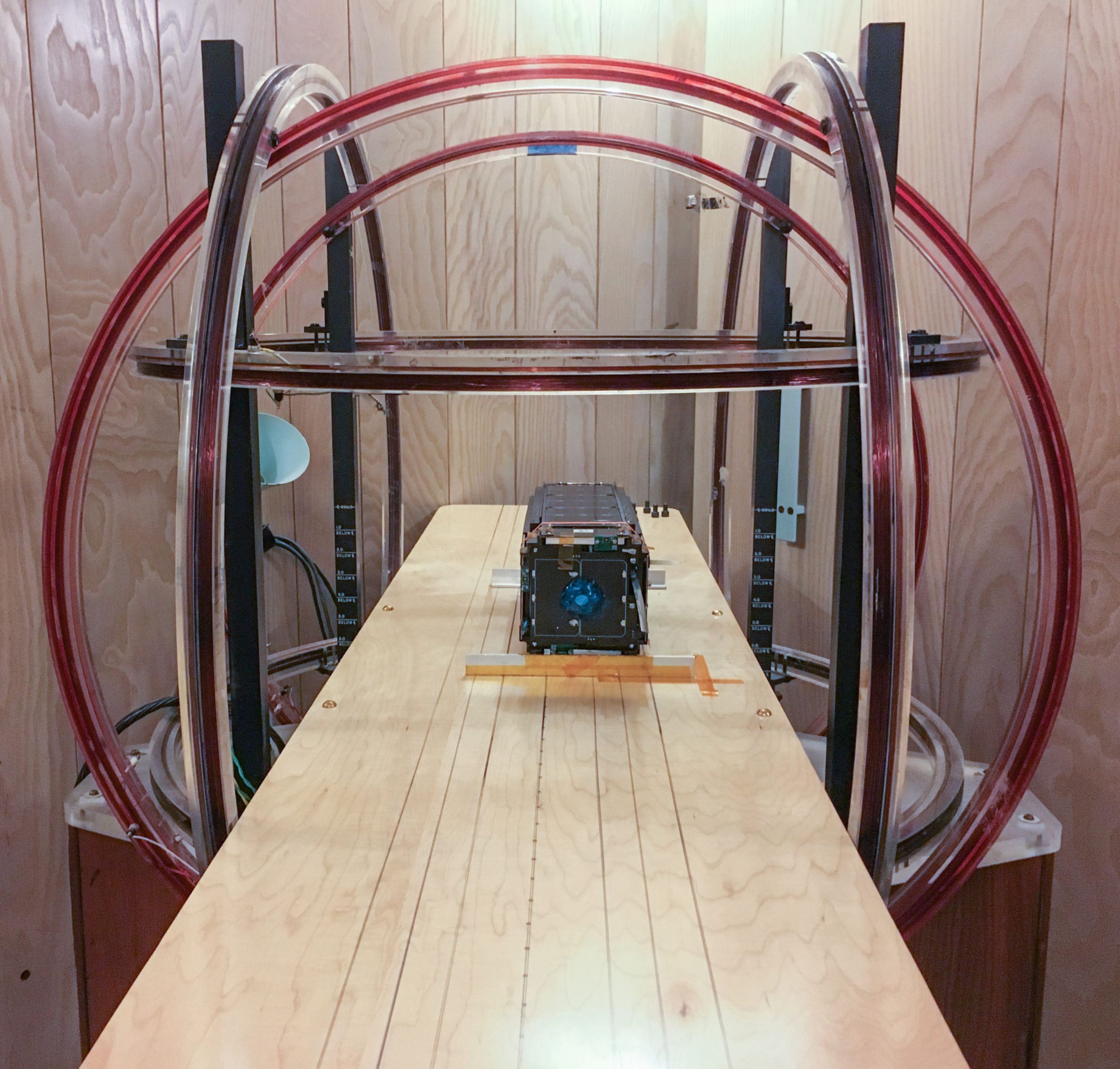Jason Davis • Jul 13, 2016
Videos and updates: LightSail 2 shows off magnetic personality
It's been a few weeks since LightSail 2 unfurled its Mylar solar sails during a day-in-the-life test at Cal Poly San Luis Obispo. What has the little CubeSat been up to? Here's a roundup of updates that were made in response to the test results, and a look at the project's next steps.
Did LightSail stop short?
The biggest anomaly during the day-in-the-life test was the booms stopping just a few motor counts shy of full deployment, as indicated by telemetry coming over the air to Cal Poly's ground station. Telemetry also showed that the motor was still active, struggling to push the booms to their imaginary finish lines. This was a potentially dangerous situation—in a worst-case scenario, one might expect smoke to start rolling from the jammed motor—so the team commanded the motor to power down.
LightSail didn't respond, so Ecliptic Enterprises Corporation engineers Riki Munakata and Alex Diaz quickly unhooked one of the four triangular sail sections, opened an access panel in the deployment table and manually powered off the spacecraft.
It turns out the motor count required for a full deployment varies slightly from deployment to deployment. This is mostly based on environmental factors, including how the sail and booms are repackaged after a test. Additionally, all four sail quadrants pull on their adjacent quadrants, but because we aren't testing in zero-G, friction and gravity prevent the sail from working itself into a more relaxed state.
So depsite the motor count, the sail was probably tight enough. The tension on the sails at the end of the deployment range—combined with boom flexure and deployment table friction—was enough to overpower the motor.
The mitigation? To be on the safe side, the team will lower future target deployment counts. We can always incrementally walk the booms out farther.
I can't hear you over this solar sail motor
Regardless of why the motor stopped, LightSail didn't respond to commands in its stuck state. The likely reason? Electromagnetic interference around the spacecraft's aft compartment from the motor itself. Check out where LightSail's antenna is located—it's right beneath the motor and boom spindle:

LightSail is able to send out telemetry chirps while the motor is running, but it apparently can't hear anything. This isn't usually a problem, since sail deployment is the biggest milestone of the mission, and a point in time where there's not much to do except sit back and watch.
Rather than solve the more difficult (and costly) problem of the interference itself, the easiest fix is adding a contingency timer to the flight software that powers off the motor after a few minutes, regardless of whether the target deployment count has been met.
Power problems
During the first phase of the day-in-the-life test, where LightSail sits in the clean room for antenna and solar panel deployment, there was some odd battery behavior.
LightSail has two battery boards holding four cells each—eight cells total. During DITL testing, not all of the cells were initially supplying power to the spacecraft. This was unexpected, but not necessarily a problem; it mostly resulted in a change in understanding about the spacecraft's power system.
However, this behavior also led to the discovery of an underlying hardware problem: one of the eight battery cells' protection circuit has failed.
When LightSail's solar panels receive sunlight, they charge the battery cells. When a battery is fully charged, its protection circuit stops more power from flowing in to that particular cell. An overcharged cell can distend, or in the worst case, catch fire.
The safest fix here is to replace the battery board with the affected protection circuit. Ecliptic has already ordered the new components and expects to have them installed in the next week or so.
Attitude (control) adjustment
I mentioned back in April that LightSail would travel to the Space Dynamics Laboratory at Utah State University for magnetometer calibrations. That test ended up being postponed until after May's day-in-the-life test, so LightSail went in early June.
Prior to that, the spacecraft made another magnetometer-related trip to the Institute of Geophysics and Planetary Physics at UCLA in Los Angeles. At the IGPP, a small, magnetically shielded room is used to block out L.A.'s noisy electromagnetic environment. LightSail was positioned inside a small, gyroscope-looking cage that generated a magnetic field, and then the spacecraft's four magnetometers reported what they saw.

By comparing LightSail's magnetometer readings with those actually generated by the cage, the team established initial error margins for each magnetometer. Those data will be used to adjust the readings that are received while the spacecraft is in orbit. At Utah State, the process was basically repeated, with an important additional step: LightSail used its electromagnetic torque rods and momentum wheel to push against the generated magnetic field and orient itself!
Next steps
The magnetic field tests turned up a couple small glitches. It turns out the magnetometer readings are affected by the position of the brushless sail motor, which changed between the UCLA and Utah State calibrations due to the day-in-the-life test. As such, the spacecraft may make one final trip back to UCLA for a final round of calibrations. Since the motor wheel might shake around during launch and deployment, the team is analyzing the spacecraft's attitude control algorithms to determine how best to account for this variable.
In an earlier blog post, I said LightSail 2 would be delivered for integration into Prox-1 in July. That has been pushed to the right a little, and we're finalizing a new schedule. LightSail's timetable depends on a number of factors, including schedules laid out by Prox-1, the Air Force Research Laboratory, and ultimately, SpaceX. We still expect to launch early next year, so we'll keep you posted.
The Time is Now.
As a Planetary Defender, you’re part of our mission to decrease the risk of Earth being hit by an asteroid or comet.
Donate Today

 Explore Worlds
Explore Worlds Find Life
Find Life Defend Earth
Defend Earth

